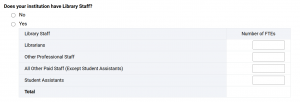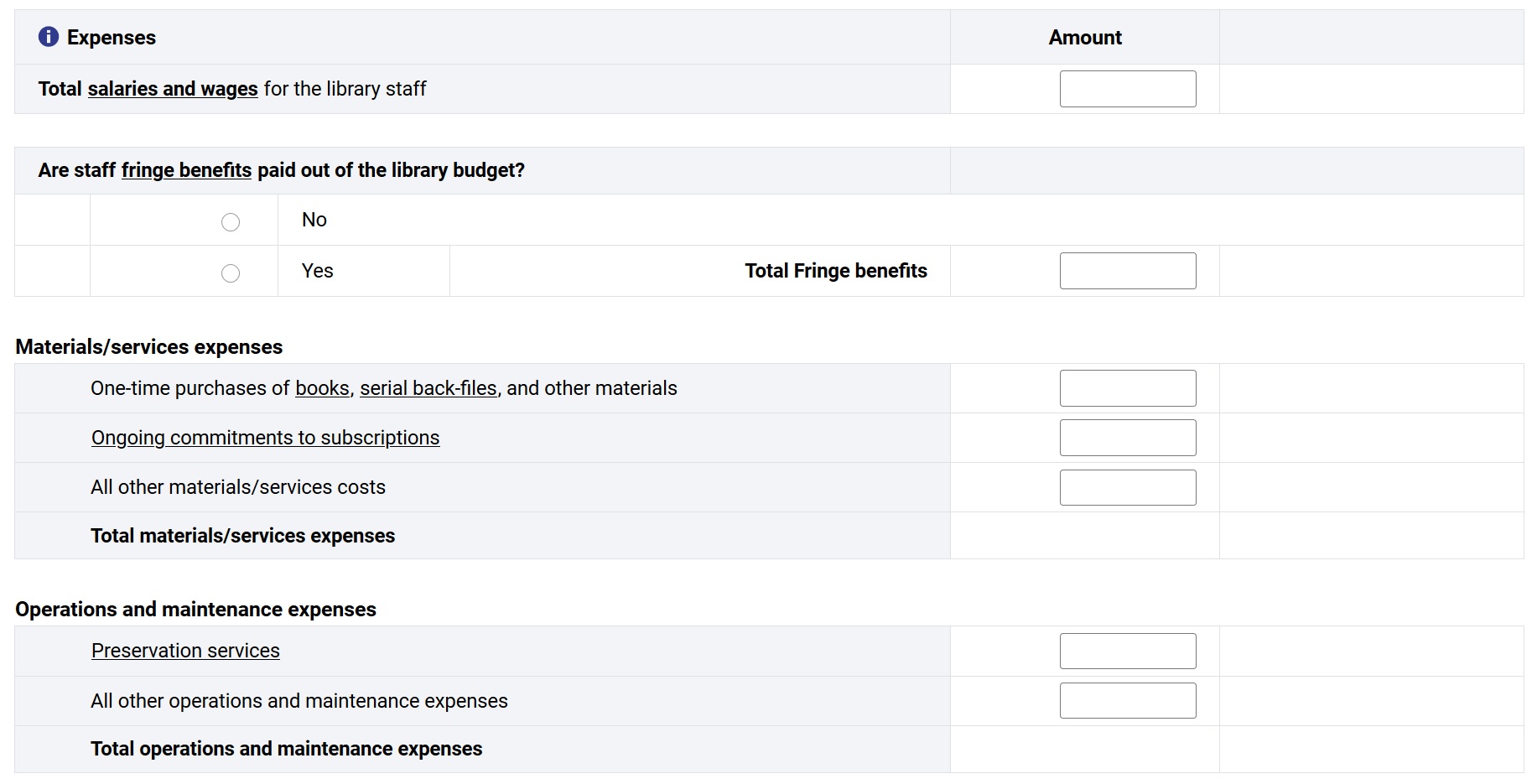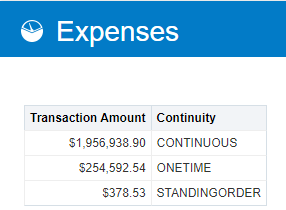5 Staff and Expenses
From IPEDS
Definitions:
Does your institution have Library Staff: Indicate whether your institution has library staff.
Report FTEs supported from the library budget. However, if known, if significant, and if specifically for library business, include FTEs funded from sources outside of the library budget. For example, for staffing counts, you may include full counts for federal work-study students working for the library, but do not include counts for maintenance and custodial staff. If there are significant counts included or excluded because of how budgeting/expenses are handled at your institution, indicate in a note whether your reporting here includes or excludes them.
Computing FTEs for part-time staff: To compute FTEs for part-time employees and student assistants, take the total number of hours worked per week by part-time employees in each category as November 1 of the fiscal year and divide it by the number of hours considered by the reporting library to be a full-time work week (e.g., 60 hours per week of part- time work divided by 40 hours per full-time week equals 1.50 FTE). Data should be reported to two decimal places.
Report Librarians by number of FTEs: “Librarians” are professional staff as defined by NISO: Staff members doing work that requires professional education in the theoretical and scientific aspects of librarianship, archives, or information studies.
Report Other professional staff by number of FTEs: Other professional staff are staff performing professional level tasks who, though not librarians, have equivalent education and training in related fields (e.g., computer sciences, business administration, education).
Report All other paid staff (except student assistants) by number of FTEs: Library staff members without formal qualification (or equivalent combination of training and experience) in librarianship, archives, information studies or other relevant specialization, not included elsewhere.
Report Student assistants by number of FTEs: Student assistants (graduate and undergraduate), employed on an hourly basis whose wages are paid from funds from the library budget or from an account(s) within the institution, including the Federal Work-Study Program.

NOTE – Expenses should be reported for the most recent 12-month period that corresponds to your institution’s fiscal year that ends before October 1, 2023. Report funds expended by the library (regardless of when received) from its regular budget and from all other sources; e.g., research grants, special projects, gifts and endowments, and fees for services. If items in this section are not paid from the library budget but can be easily identified in other parts of the institution’s budget, report them here. The exception is fringe benefits — report fringe benefits only IF paid from the library budget. All expenses should be reported in whole dollars in the most appropriate category to provide an unduplicated count of expenses. Exclude expenses for new buildings and building renovation. Include any library-related expenses that are covered by Coronavirus Aid, Relief, and Economic Security (CARES) Act funds in the appropriate expense sections.
Total salaries and wages – Report salaries and wages before deductions for all full-time and part-time library staff, including student assistant wage and Federal Work-Study students’ wage, from the library budget or all other institutional sources that are identifiable.
Staff fringe benefits – If benefits are paid from the library budget, select ‘yes’ and report the amount. If benefits are not paid from the library budget, select ‘no’ and report ‘0’ for the amount.
Total amount of fringe benefits (if paid by library budget) – If fringe benefits are paid by the library budget, report all cash contributions in the form of supplementary or deferred compensation other than salary. Do not include the employee’s contribution. Employee fringe benefits include retirement plans, social security taxes, medical/dental plans, unemployment compensation plans, group life insurance plans, worker’s compensation plans, and other benefits in-kind with cash options. Exclude employee fringe benefits if not paid from the library budget.
Materials/Service Cost
One-time purchases of books, serial back-files, and other materials – Provide the cost of one-time purchases of books, serial back-files, and other materials. Report expenses for published materials in all formats including archives and special collections. Include one-time acquisitions of access rights for digital/electronic materials held locally and for remote materials for which permanent access rights have been acquired. Include expenses for database licenses only if they are not a subscription or part of an annual consortium fee. Do not include expenses for computer software used to support library operations or to link external networks, including the Internet. This is reported under other operations and maintenance expenses.
Ongoing commitments to subscriptions – Report expenses for ongoing commitments in all formats, including duplicates, for all outlets. This includes serials and any other items committed to annually, as well as annual electronic platform or access fees. Serials are publications issued in successive parts, usually at regular intervals, and, as a rule, intended to be continued indefinitely. Print-based serial subscriptions include periodicals, newspapers, annuals (reports, yearbooks, etc.), memoirs, proceedings, and transactions of societies. Include the costs of electronic serials bought in aggregations and serial packages. Include abstracting and indexing services and any database that requires an annual subscription fee. Do not include subscription fees if they are part of an annual consortium fee. Government documents received serially are included if they are accessible through the library’s catalog or discovery system.
Other materials/service cost – Report additional materials/service costs that have not already been reported in this section. Other materials/service costs may include:
- Document delivery/interlibrary loan services. Include fees paid for photocopies, costs of facsimile transmissions, royalties and access fees paid to provide document delivery or interlibrary loan. Include the interlibrary loan fees paid to bibliographic utilities if the interlibrary loan costs paid can be separated out from the expenses paid to the bibliographic utility. Do not count expenses related to transactions between the main or central library and branches, transactions between branches, or expenses for an on-campus delivery. Include costs associated with pay-per-view journal article transactions. Include fees expended for short-term loans as part of a Patron-Driven Acquisition (PDA) or Demand-Driven Acquisition (DDA) program.
- Other expenses for information resources. Include copyright fees and fees for database searches, e.g., (DIALOG, Lexis-Nexis).
Operations and Maintenance Expenses
Preservation services – Report expenses associated with maintaining library and archival materials for use either in their original physical form or in some other usable way. This includes but is not limited to binding and rebinding, materials conservation, de-acidification, lamination, and restoration. Also, include preservation-related contracts for services (e.g., digitization). Do not include staff salaries and wages.
All other operations and maintenance expenses – Report any other maintenance expenses that have not already been reported in this section. Include:
- Computer hardware and software expenses. Report expenses from the library budget for computer hardware and software used to support library operations, whether purchased or leased, local or remote. Include the expenses for equipment used to run information service products when that expense can be separated from the price of the product.
- National, regional, and local bibliographic utilities, networks and consortia.
- If interlibrary loan fees paid to bibliographic utilities cannot be separated out, include the interlibrary loan costs here with the library’s expenses of the bibliographic utilities.
- All other operating expenses. Report all other expenses from the library budget not already reported. Exclude expenses for new buildings and building renovations. Include all expenses for furniture and equipment. Include any related maintenance costs.

Salaries and Wages
This information is not in Alma. Possible resources:
- Business Office
- Human Resources
- ISRS if you have the right type of access
Materials Expenses
- If you are using Acquisitions, open the Expenses Report in Alma Analytics.
- Change the date prompt if needed and click OK.
- Look it over (you may need to add or subtract things depending on your unique situation).
- Add lines together so that you have a total for one-time and a total for ongoing expenses.
- If you need to edit the report, be sure to save it to your institutional folder.

If you are not using Acquisitions in Alma, possible resources are:
- Business Office
- ISRS if you have the right type of access
You might also keep your own spreadsheet to check against the figures from the Business Office. (Sometimes items are mistakenly charged to the library and need to be fixed, so this is a good practice.)

